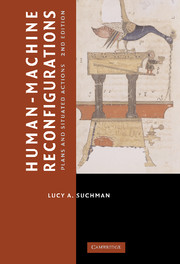Book contents
- Frontmatter
- Contents
- Acknowledgments
- Preface to the 2nd Edition
- Introduction
- 1 Readings and Responses
- 2 Preface to the 1st Edition
- 3 Introduction to the 1st Edition
- 4 Interactive Artifacts
- 5 Plans
- 6 Situated Actions
- 7 Communicative Resources
- 8 Case and Methods
- 9 Human–Machine Communication
- 10 Conclusion to the 1st Edition
- 11 Plans, Scripts, and Other Ordering Devices
- 12 Agencies at the Interface
- 13 Figuring the Human in AI and Robotics
- 14 Demystifications and Reenchantments of the Humanlike Machine
- 15 Reconfigurations
- References
- Index
7 - Communicative Resources
Published online by Cambridge University Press: 05 June 2012
- Frontmatter
- Contents
- Acknowledgments
- Preface to the 2nd Edition
- Introduction
- 1 Readings and Responses
- 2 Preface to the 1st Edition
- 3 Introduction to the 1st Edition
- 4 Interactive Artifacts
- 5 Plans
- 6 Situated Actions
- 7 Communicative Resources
- 8 Case and Methods
- 9 Human–Machine Communication
- 10 Conclusion to the 1st Edition
- 11 Plans, Scripts, and Other Ordering Devices
- 12 Agencies at the Interface
- 13 Figuring the Human in AI and Robotics
- 14 Demystifications and Reenchantments of the Humanlike Machine
- 15 Reconfigurations
- References
- Index
Summary
Thus the whole framework of conversational constraints can become something to honor, to invert, or to disregard, depending as the mood strikes.
(Goffman 1975: 311)Communicative action occurs in particular moments of actual time, in particular relationships of simultaneity and sequence. These relationships in time, taken together, constitute a regular rhythmic pattern. This regularity in time and timing seems to play an essential, constitutive role in the social organization of interaction … Whereas there is no metronome playing while people talk, their talking itself serves as a metronome.
(Erickson 1982: 72)We are environments for each other.
(McDermott 1976: 27)An argument of the preceding chapters was that we never definitively determine the intent behind an action, in that descriptions at the level of intent are not designed to pick out mental states that stand in some relation of strict causality to action or even, in any strong sense, of one-to-one correspondence. Instead, intentional descriptions classify over situations and actions, as typifications that invariably include an “open horizon of unexplored content” (Schutz 1962: 14). In spite of this inherent indeterminacy, intentional descriptions not only suffice to classify purposeful behavior but, given the unique and fleeting circumstances of action and the need to represent it efficiently, seem ideally suited to the task. Attributing intent in any particular instance, moreover, is generally nonproblematic, even transparent, for members of the society who, from their practical perspective and for their practical purposes, are engaged in the everyday business of making sense out of each other's actions.
- Type
- Chapter
- Information
- Human-Machine ReconfigurationsPlans and Situated Actions, pp. 85 - 108Publisher: Cambridge University PressPrint publication year: 2006

